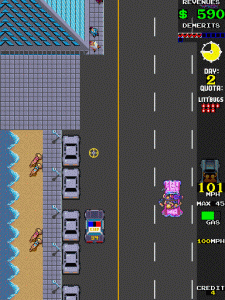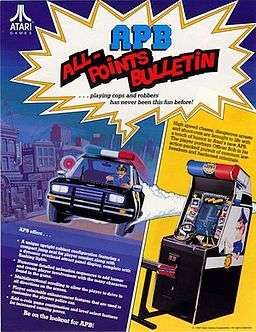APB (1987 video game)
| APB | |
|---|---|
|
Promotional flyer picturing the arcade cabinet with attached seat | |
| Developer(s) | Atari Games |
| Publisher(s) | Atari Games |
| Distributor(s) | Atari Games |
| Designer(s) | Mike Hally |
| Programmer(s) | David Theurer, Alan Murphy, Russell Dawe |
| Artist(s) | Mike West |
| Composer(s) | Brad Fuller, Hal Canon, Earl Vickers |
| Platform(s) | Arcade |
| Release date(s) |
1987 Arcade 1989 Amiga, Atari ST, C64, ZX Spectrum 1991 Lynx |
| Genre(s) | Vehicular combat |
| Mode(s) | Single-player |
| Cabinet | Standard and sit-down (convertible) |
| Arcade system | Atari System 2 |
| Display | Vertical orientation, 19", Raster, medium resolution |
APB ("All Points Bulletin") is a 1987 arcade game by Atari Games. In the game, the player assumes the role of "Officer Bob," a rookie police officer. As Bob, players drive around the city, ticketing motorists for minor infractions and pulling over more serious offenders. Eventually, players must apprehend criminals for which an all points bulletin has been called.
The game was noted at the time of release for its presentation. The arcade cabinet was created to look like a police car, with a gas pedal, steering wheel and a siren button, complete with flashing lights atop the unit. The game's cartoonish visuals and sense of humor gained it positive reviews. However, the game was slightly criticized for its difficulty; the game's developers later admitted that a long development cycle had resulted in the gameplay growing more complicated than originally planned.
Versions of the game were released for various computer systems, as well as the handheld Atari Lynx. An emulated version of the game was made available as part of Midway Arcade Treasures 2, Midway Arcade Treasures Deluxe Edition, and Midway Arcade Origins.
Gameplay

The object of the game is to meet (or exceed) the daily quota of citing or arresting various types of law-breakers within a time limit for the day. The player is given an overhead view of Officer Bob's patrol car, number 54. The player controls the car with a gas pedal and a steering wheel.[1] Bonuses are awarded for a "perfect day" and each arrest over the quota. Picking up donuts extends the time limit for a day. Driving through filling stations refuels the patrol car. Driving through the garage daily upgrades the patrol car with brakes, guns, armor, radar, etc.[2]
The game begins by having the player ticket common misdemeanor infractions (such as littering) by pulling up behind them, pushing the siren button and having them pull over. Certain offenders require more siren taps to be pulled over. Specific offenses are tied directly to distinctive vehicles (e.g., only the pink convertibles toss litter, and that is the only offense they will commit.) The exception to this is speeding, eventually introduced into the game, which can be perpetrated by any vehicle.
The game also gives the player the task of arresting fugitive felons. Every other day, starting on the third day, the player can go after an A.P.B. ("All Points Bulletin").[3] When a fugitive is caught and returned to the station, the player must violently shake the suspect to get a confession before the Chief enters the room. This is done by filling the "Confess-O-Meter" by tapping alternatively on the "fire" and "siren" buttons.[4] After Day 16, no other petty violators are introduced. The daily quota will be a combination of those above, with a few "Helps"(stranded motorists) and hitchhikers thrown in.
The game's life gauge of sorts is a demerit meter. The game ends when this meter is maxed out. When the demerit limit is reached, the message "TOO MANY DEMERITS. YOU ARE FIRED."[1] is displayed. Demerits are gotten for colliding with cones and other vehicles with the siren off, shooting non-offender vehicles, running into donut huts and pedestrians, running out of gas (if the quota is met), and failing to get a confession from an A.P.B. Also, demerits come from the player's car exploding, from getting hit by trains or dynamite, high-speed collisions with obstacles, and attempting to jump construction pits at too low a speed. Finally, failing to make quota at the day's end earns one demerit per unmet quota.
The game cabinet is generally a standard upright. The main controls consist of a steering wheel, a siren button, a "fire" button for the gun and an accelerator pedal. The cabinet has two lights on top, red and blue, which flash when the player presses the siren button.[1] Units feature a detachable seat which can be used to convert the cabinet into a sit-down game.
Development
According to members of the team that worked on the game, APB had an extended development process. Throughout the lengthy development, new gameplay ideas such as the in-game shops were continually added. The developers admitted that as a result, the final game may have been overly complex.[5]
Reception
The game enjoyed moderate success in the marketplace. Its high-resolution graphics and novel cabinet design, with the flashing lights atop, added to its initial appeal.[1] The game was noted for its increasing difficulty, with The Games Machine calling it at times "utterly frustrating."[3] However, the game's cartoonish graphics and sound along with its humor were well-received, with Your Sinclair calling it "one of the funniest games of the year" and Computer and Video Games calling it "hilarious."[2][4] The unique gameplay was also lauded; The Games Machine called it "like a breath of fresh air." and Crash said the game was "refreshingly different from the usual mass of bash-or-blast'em ups"[1][3]
In a retrospective review for Allgame, Paul Biondich wrote that the gameplay "stood the test of time" and that the arcade cabinet's unique design set the game apart in arcades. He also wrote that ten years after its release, the game was still graphically impressive. In addition, he complimented the game's depth, difficulty curve and replay value.[6]
Ports
APB was ported to the Atari ST, Amiga, ZX Spectrum, Commodore 64 and in 1991 released on the Atari Lynx. These ports were mostly developed by Tengen and published by Domark.[7][8] The game came to the GameCube, PlayStation 2 and Xbox as part of Midway Arcade Treasures 2 and to PCs as part of Midway Arcade Treasures Deluxe Edition.[9][10] It was released again as part of the compilation Midway Arcade Origins in 2012.[11]
References
- 1 2 3 4 5 "APB" Crash. October 1987. p.137.
- 1 2 "APB" Computer+Video Games. November 1987.
- 1 2 3 "A.P.B." The Games Machine. February 1988. p. 70.
- 1 2 Shaw, Peter. "All Points Bulletin". Your Sinclair. November 1987.
- ↑ Digital Eclipse, Backbone Entertainment (2004-10-11). Midway Arcade Treasures 2. PlayStation 2, Xbox. Midway Games.
- ↑ Biondich, Paul. "A.P.B. - Overview". All Game. Rovi. Retrieved August 16, 2012.
- ↑ APB. Zzap! October 1989. p.18.
- ↑ Knight, Kyle. "A.P.B. - Review". All Game. Rovi. Retrieved August 16, 2012.
- ↑ "Midway Arcade Treasures 2 Review". 1UP.com. 2004-10-13. Retrieved 2008-11-16.
- ↑ Gerstmann, Jeff (February 28, 2006). "Midway Arcade Treasures Deluxe Edition Review". GameSpot. Retrieved August 16, 2012.
- ↑ http://www.ign.com/articles/2012/11/14/midway-arcade-origins-review
External links
- APB at the Killer List of Videogames
- APB at the Arcade History database
- APB at World of Spectrum
